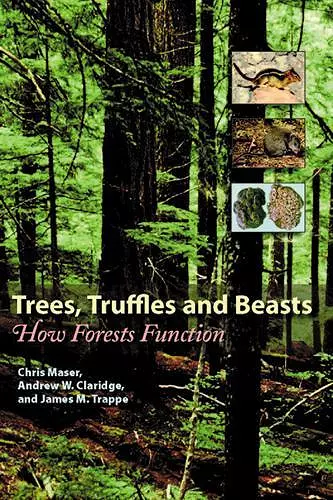Trees, Truffles, and Beasts
How Forests Function
Chris Maser author Andrew W Claridge author James M Trappe author
Format:Paperback
Publisher:Rutgers University Press
Published:4th Jan '08
Currently unavailable, and unfortunately no date known when it will be back

In today's world of specialization, people are attempting to protect the Earth's fragile state by swapping limousines for hybrids and pesticide-laced foods for organic produce. At other times, environmental awareness is translated into public relations gimmicks or trendy commodities. Moreover, simplistic policies, like single-species protection or planting ten trees for every tree cut down, are touted as bureaucratic or industrial panaceas.
Because today's decisions are tomorrow's consequences, every small effort makes a difference, but a broader understanding of our environmental problems is necessary to the development of sustainable ecosystem policies. In Trees, Truffles, and Beasts, Chris Maser, Andrew W. Claridge, and James M. Trappe make a compelling case that we must first understand the complexity and interdependency of species and habitats from the microscopic level to the gigantic. Comparing forests in the Pacific Northwestern United States and Southeastern mainland of Australia, the authors show how easily observable species, trees and mammals are part of a complicated infrastructure that includes fungi, lichens, and organisms invisible to the naked eye, such as microbes.
Eminently readable, this important book shows that forests are far more complicated than most of us might think, which means simplistic policies will not save them. Understanding the biophysical intricacies of our life-support systems just might.
Accurate and authentic, Trees, Truffles, and Beasts makes a major contribution to the field of natural resource management. This is a clear and compelling argument that there's much more to forests than meets the eye. -- Jim Furnish * Deputy Chief (ret.), USDA Forest Service *
This book is an excellent introduction to the world of mycorrhizal fungi in forests and their importance in food webs as highlighted by truffles. This book should encourage readers to investigate further the intricate and essential interactions occurring in forests, which make them work. -- John Dighton * professor and director of Rutgers University Pinelands Field Station *
"The book provides excellent coverage of the symbiosis between trees, fungi, and animals, an orverarching theme. . . . Few works take these personal views into account to give such a holistic view of the forested landscape. Highly recommended." * Choice *
The authors. all keenly qualified to write on the topic, begin by discussing the importance of sustainable ecosystem policies and preserving our environment, and then point out that to be able to do that, one must understand those environmental systems. What follows is an entire college course on just how forests work. * Funghi *
These authors weave together a broad array of personal observations and pertinent scientific research into a sweeping account of forest ecology and conservation. This book is an interesting and well-priced addition to the mycologist's bookshelf. * Inoculum *
Trees, Truffles, and Beasts reveals a belowground world that we cannot see, and for that reason, often overlook when thinking about forests. The authors deftly link this belowground world of fungi and soil microorganisms to the aboveground world that we know. The story-telling style of writing makes the book engaging and easy to read, and at the same time, the book is packed with interesting facts. * Northwest Science *
"Lucidly written and accessible to professionals and the general public alike, the authors adeptly tease out the intimate details and fascinating ecological interactions of a world hidden within the soil. I highly recommend this book for a fascinating glimpse into the wondrous web life and complex ecological relationships that sustain our natural forests." -- Alan Watson Featherstone * Trees for Life, Scotland *
ISBN: 9780813542263
Dimensions: 235mm x 152mm x 20mm
Weight: 539g
280 pages